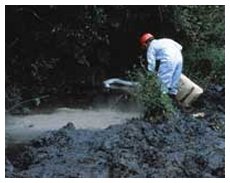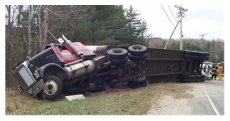Chemical Accident Prevention Enforcement

Clean Air Act General Duty Clause
Under the Clean Air Act (CAA), in the 1990 Clean Air
Act Amendments, Congress added Section 112(r) to the statute.
Section 112(r), requires owners and operators of stationary sources
to identify hazards, and prevent and minimize the effects of accidental
releases wherever extremely hazardous substances are present at
their facility. This section was added to improve facilities'
accident prevention and emergency preparedness. Section 112(r)
encompasses both the General Duty Clause of Section 112(r)(1)
and the Risk Management Program of Section 112(r)(7). Some of
the other environmental statutes have similar provisions relating
to accidental chemical releases.

Relationship Between Clean Air Act and Prevention of Accidental
Releases Section
The General Duty Clause applies to any facility were extremely
hazardous substances are present. The Risk Management Program
applies to a subset of these facilities were certain substances
above a threshold level. The Risk Management Program is a regulatory
program developed by EPA, found at 40 C.F.R. Part 68, which emphasizes
hazard assessment, prevention and response. Information on the
Risk Management Program, provided by EPA's
Chemical Emergency Preparedness and Prevention Office (CEPPO)
is available at the following web site.
The General Duty Clause refers to the release of "extremely
hazardous substances," but these are not defined in the statute.
EPA has adopted a broad interpretation of the term "extremely
hazardous substances" that includes various lists of hazardous
substances, toxic substances, and chemicals that it has identified
in its regulations relating to the statute.
 The
goals of the General Duty Clause are to: The
goals of the General Duty Clause are to:
- Identify hazards through a hazard assessment
- Prevent and minimize effects of accidental release
- Provide emergency response for accidental releases
Risk Management Program
Although there are some provisions of the 1990 Clean
Air Act Amendments which are self-implementing (that is, no regulations
are needed), the Clean Air Act directed EPA to develop regulations
for implementing a Risk Management Program. The Risk Management
Plan Rule implemented Section 112(r) of the amendments. (Additional
Information)
General Duty Clause Enforcement
The General Duty Clause is a self-implementing provision unlike
the Risk Management Regulations. EPA was given authority to enforce
for the General Duty Clause in Section 112(r)(1), with it being
enforceable since November 15, 1990. It imposes three primary
obligations on owners and operators of stationary sources and
facilities. First, owners and operators must identify hazards
that may result in accidental releases by appropriate hazard assessment
techniques. Second, owners and operators must design and maintain
a safe facility taking such steps as are necessary to prevent
releases. Third, owners and operators must minimize the consequences
of accidental releases which do occur . .
- Who must comply with the provisions of the General Duty
Clause?
All facilities where extremely hazardous substances are present
must comply.
- What are the penalties for noncompliance?
Since the General
Duty Clause is a part of the Clean Air Act, the penalties
for violations are specified in that statute
as being a maximum of $27,500 per day per violation.
Other Federal Laws and Regulations Relating to Releases of Extremely
Hazardous Substances and Chemical Accident Prevention
 Emergency
Planning and Community Right to Know Act of 1986 (EPCRA) Emergency
Planning and Community Right to Know Act of 1986 (EPCRA)
One part of EPCRA requires businesses to report on emissions of
certain toxic chemicals with that information being included in
the Toxics Release Inventory, a publicly-accessible data bank.
The other part of the law requires certain businesses to report
releases of extremely hazardous chemicals to state and local authorities,
and to disclose to those same authorities the quantities and types
of toxic chemicals stored on site. (EPCRA
Enforcement Site)
Resource Conservation and Recovery Act of 1976 (RCRA)
RCRA, under Subtitle C, requires "cradle to grave" management
of any and all hazardous wastes and hazardous substances which
are RCRA listed or characteristic. This includes many substances
covered under the "extremely hazardous substances" of
the Clean Air Act's General Duty Clause. In addition, RCRA statutory
authorities gives EPA the ability to issue RCRA Section 7003 Orders
when there is evidence that the past or present handling, storage,
treatment, transportation or disposal of hazardous or nonhazardous
waste may present an "imminent and substantial endangerment to
health or the environment". These ordered, issued to any past
or present entity (i.e., generators, transporters, or owners or
operators) can order that steps be taken to clean up the facility
or location or to change or stop the operating procedure causing
a release and endangerment to public health or the environment.
 Also,
RCRA has requirements for transport, storage and disposal facilities
(TSDs) and generators to have contingency plans to respond to
accidents (40 C.F.R. 264 and 265). Also,
RCRA has requirements for transport, storage and disposal facilities
(TSDs) and generators to have contingency plans to respond to
accidents (40 C.F.R. 264 and 265).
Information on the other federal hazardous waste laws and regulations
can be found in the Office of Solid Waste's Laws,
Regulations, and Policies section which lists documents and
other information organized by subject. (RCRA
Enforcement Site)
Toxic Substances Control Act of 1976 (TSCA)
This is a comprehensive statute that authorized the control of
untested chemicals for their potential health or environmental
effects. The "extremely hazardous substances" of the
Clean Air Act's General Duty Clause are TSCA listed chemicals,
with the TSCA listed chemicals list being used as one of the lists
in defining the "extremely hazardous substances". (TSCA
Enforcement Information)
Comprehensive Environmental Response, Compensation, and Liability
Act of 1980 (CERCLA), also known as "Superfund"
This law was enacted to address the problems of hazardous waste
(including hazardous substances) found at inactive or abandoned
sites and facilities or those resulting from spills that require
emergency response. Releases of "extremely hazardous substances"
at inactive and/or abandoned sites and facilities are regulated
by CERCLA. In addition, CERCLA Section 103 addresses the reporting
of releases of hazardous substances. (CERCLA
Enforcement Information)
State Laws and Regulations Relating to Releases of Extremely Hazardous
Substances and Chemical Accident Prevention
The Clean Air Act (CAA) provides the federal government with the
authority to delegate the ability to implement and enforce provisions
of the Clean Air Act. The Chemical Emergency Preparedness and
Prevention Office maintains a list of states which have received
delegaton of the Risk Management Program. (Information
on Risk Management Plan Delegated States)
Other Information Resources
EPA's Chemical Emergency Preparedness
and Prevention Office CEPPO)
Emergency Planning and Community
Right-to-Know Act (EPCRA)
CEPPO's Preparedness
and Community Right-to-Know Information
New Ways
to Prevent Chemical Incidents (May 1999) (EPA 550-B-99-012)
(Links to National Safety Council Web Site)  (PDF, 681.5KB, 12 pages)
(PDF, 681.5KB, 12 pages)
Clean Air Act Section 112(r) Hotline: (800) 424-9346 or (703)
412-9810
|

